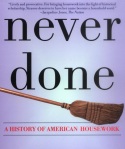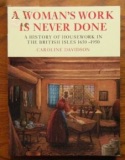-
History of:
- Resources about:
- More:
- Baby walkers
- Bakehouses
- Bed warmers
- Beer, ale mullers
- Besoms, broom-making
- Box, cabinet, and press beds
- Butter crocks, coolers
- Candle snuffers, tallow
- Clothes horses, airers
- Cooking on a peat fire
- Drying grounds
- Enamel cookware
- Fireplaces
- Irons for frills & ruffles
- Knitting sheaths, belts
- Laundry starch
- Log cabin beds
- Lye and chamber-lye
- Mangles
- Marseilles quilts
- Medieval beds
- Rag rugs
- Rushlights, dips & nips
- Straw mattresses
- Sugar cutters - nips & tongs
- Tablecloths
- Tinderboxes
- Washing bats and beetles
- Washing dollies
- List of all articles
Subscribe to RSS feed or get email updates.
There is a race of hereditary sand-sellers, or "sond-knockers," in Smallbridge ... who live by crushing sandstone rock, for sale in the town of Rochdale, and the villages about it. This sand is used for strewing upon the flagged house floors, when the floor is clean washed; and while it is yet damp, the sand is ground over it by the motion of a heavy "scouring-stone", to which a long, strong, wooden handle is firmly fixed, by being fastened to an iron claw, which grasps the stone, and is embedded into it by molten lead. The motion of the "scouring-stone" works the flags into smoothness, and leaves an ornamental whiteness on the floor when it gets dry; it breeds dust, however, and much needless labour.
Waugh's Lancashire Sketches, 1869

Susan Strasser, Never Done: A History of American Housework from Amazon.comor from Amazon UK


Caroline Davidson, A Woman's Work is Never Done: a History of Housework in the British Isles 1650-1950 from Amazon.comor from Amazon UK

Bricks and Scouring Stones are ... sold at the oil-shop, the former for cleaning knives, for which they are specially made, containing a large proportion of sharp sand. The stone for cleaning flags [flagstone floors] is a lime-stone obtained from the nearest suitable locality, and sold per lump.
Rottenstone is an earth of an ashbrown colour, very light, moderately hard, dry, and useful as a polishing powder.
JH Walsh, Manual of Domestic Economy, 1856
Stone, sand, and brick for scouring
>>>> Donkey Stones - lower down page
Scrubbing floors & traditional ways of cleaning wood, stone, and metal
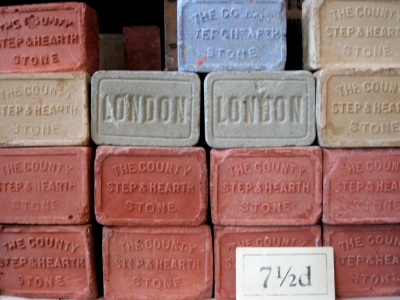 Today we have detergents, household
cleansers, and steel wool. But what did people use to shift dirt from unpainted,
uncarpeted floors before modern technology? How did they deal with burnt food and
rust on iron cooking pots?
Today we have detergents, household
cleansers, and steel wool. But what did people use to shift dirt from unpainted,
uncarpeted floors before modern technology? How did they deal with burnt food and
rust on iron cooking pots?
Sand is an important part of the answer, along with stone and brick. Soap was also available for those who could afford to buy it for general chores, or who could make it themselves.
You could scour with sand, using a brush or a cloth, and it must have been hard work. Because this kind of job was done by the same poor women who did other people's laundry, there is not much written about it. Information comes from the household accounts of wealthy homes, and a couple of 18th century domestic advice manuals written by housekeepers. These have some of the earliest descriptions of how these tasks were tackled. "Lady" writers whose interest in home management didn't extend to scrubbing floors often skip over this topic. Catherine Beecher, for example, who gives so much detail about kitchen and household planning, has a detailed list of essential equipment that tails away when it gets to basic cleaning. She just mentions brooms, brushes, cloths and "other articles used in cleansing".
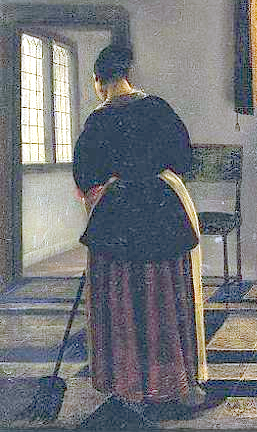 In 1753 Mary Johnson gave her views on best practices in cleaning. She described
herself as a "Superintendent of a Lady of Quality's Family" (in York,
England). Housemaids working under her may have found her high standards a little
daunting. Her book,
Madam Johnson's Present, says how "very industrious" they
should be. She wanted them to use sand for scrubbing dirty stoneware, the outside
of copper pots, pewter (using sand mixed with lye),
and more, but they must never use sand on wooden dressers.
In 1753 Mary Johnson gave her views on best practices in cleaning. She described
herself as a "Superintendent of a Lady of Quality's Family" (in York,
England). Housemaids working under her may have found her high standards a little
daunting. Her book,
Madam Johnson's Present, says how "very industrious" they
should be. She wanted them to use sand for scrubbing dirty stoneware, the outside
of copper pots, pewter (using sand mixed with lye),
and more, but they must never use sand on wooden dressers.
Floor cleaning is explained at length. If you were going to clean a wooden floor you must start the night before by putting ox-gall on greasy spots. Next morning a "strong hot Lye, made of Wood-Ashes" went on the whole floor. After spreading clean sand over that, the maid was to get on her knees and scour the boards with a hard brush. A second tour of the floor with a clean cloth was required before the final wipe with yet another cloth to speed up drying and keep the wood light in colour. Then you were through except for oiling the skirting boards, as long as the floor wasn't dirty enough to need a longer treatment with more sand and cold water.
More than a century later, and on the other side of the Atlantic, the method was much the same in simple homes with plain wooden floors, but soap was recommended too:
Scouring ... almost disappears before civilization, being superseded by the use of paint on the wood-work of our houses, floors of halls and kitchens... Nevertheless... we feel a kind of reverent admiration for the pioneer mothers who, with large families and small houses, all guiltless of paint or carpets, kept the very floors clean enough to have taken a meal from...
Look over the vessel or floor to be scoured, and over any grease spots rub a mixture of soap and sand — (if the spots are in soft wood or look obstinate, strong brown soap and hot ashes are better.) Rub these with a stout floor cloth or scrub-broom, well. Then sprinkle clean river sand, or finely pulverized sand stone, over the floor, pour on enough hot soap suds, and scrub perseveringly until grease marks and dirt are eradicated. Then continue to rinse your floor with clean water until the water is colorless. You may be sure your work is well done then, and you may proceed to dry the floor with a clean mop or clean floor cloth. Small scrub-brooms, made of splits of some tough wood, are best for tables, vessels and the like, and old, soft, coarse linen the best floor cloths, where mops are not to be had, as they are not generally in our new States.
Godey's and other US magazines, 1864
Stone floors and stairs got similar treatment, and so did stone hearths under Madam Johnson's supervision. She didn't like "firestones" for cleaning: "...rubbing with a Fire-stone spoils the Ladies Petticoats, and one cannot set a Foot on Slabs, so rubbed, without marking the Room..."
So what was a firestone?
Scrubbing stones, hearthstones, firestones, donkey stones
Firestone was the word Mary Johnson used, but there were many other names for scrubbing stones. Basic stone or brick floor cleaners were called Scouring stone, Scrubbing stone, Fire-stone, or Hearth-stone. Sailors scrubbing decks with sandstone called theirs Holystone. Firestone and hearthstone were used as verbs:
Here is a clean little commercial inn, its floors well hearthstoned, bearing a right ancient commercial sign, " The Woolpack."
Anon in Dickens' Household Words, 1851
They could be plain chunks of abrasive stone. Otherwise these were generally mixtures of sand or pulverised stone or clay formed into brick-shaped "stones". Real building brick was also used. Flanders Tile, Flanders Brick, or Dutch Brick was imported into England from late medieval times and was a familiar cleaning tool. In 1684 "Flanders Tyle, to scour with" cost Irish importers £2 customs duty per 1000 pieces. In 18th and 19th century London Flanders tile and hearthstones were sold by street vendors with hand-carts.
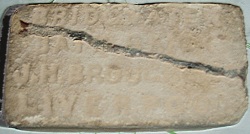 "Bath
brick" (pictured left) was a specialised cleaner usually kept for
knives, though it could be used on other surfaces. Rottenstone, similar to "tripoli",
was made from powdered limestone to scour metal and sometimes wood. Some recipes
for scouring substances used pipeclay (fine whitish clay) or whiting (chalk).
"Bath
brick" (pictured left) was a specialised cleaner usually kept for
knives, though it could be used on other surfaces. Rottenstone, similar to "tripoli",
was made from powdered limestone to scour metal and sometimes wood. Some recipes
for scouring substances used pipeclay (fine whitish clay) or whiting (chalk).
Stone floors and stone stairs are sometimes scrubbed with sand and water, sometimes with the hearth-stone, or with pipe-clay prepared after the following receipt: Boil half a pint of size [glue] with the same quantity of whiting and pipe-clay in two quarts of water; the stones must be first washed clean with water, and this mixture afterward laid smoothly on them with a flannel; when dry, they must be rubbed with a dry cloth or flannel. Stone floored kitchens and offices, stone hearths, stone steps, and balconies are usually washed with a flannel and water, and, while wet, scrubbed with the hearth-stone. Steps at the entrances of houses are washed and whitened every day in town, in the country scarcely more than once a week; stone kitchens twice a week, balconies only once.
Webster's Encyclopedia of Domestic Economy, New York 1845 and later editions
 Branded scrubbing
stones were popular in northern England well into the 20th century. Well-scrubbed
doorsteps were a proud sign of
good housekeeping in rows of small terraced houses in smoky industrial towns.
Stones manufactured in the 19th and 20th centuries often had some colouring added
(see picture at top of page). Earlier, simpler versions had no colour except perhaps
a touch of white chalk or pale clay. Steps and windowsills were not only scoured
but also tinted and/or outlined in white. A donkey picture on one well-known brand
gave its name to this type of scrubbing stone, even though there was plenty of competition.
Other stones on sale were marked with lions, ponies, or a kneeling woman for the
Kitchen brand.
Branded scrubbing
stones were popular in northern England well into the 20th century. Well-scrubbed
doorsteps were a proud sign of
good housekeeping in rows of small terraced houses in smoky industrial towns.
Stones manufactured in the 19th and 20th centuries often had some colouring added
(see picture at top of page). Earlier, simpler versions had no colour except perhaps
a touch of white chalk or pale clay. Steps and windowsills were not only scoured
but also tinted and/or outlined in white. A donkey picture on one well-known brand
gave its name to this type of scrubbing stone, even though there was plenty of competition.
Other stones on sale were marked with lions, ponies, or a kneeling woman for the
Kitchen brand.
...an essential part of the Yorkshire and Lancashire housewife's stock-in-trade was the bright yellow scouring stone for the hearth and doorstep and the white one for outlining.
Harold Priestley, The English Home, 1971
Plenty of people living today remember a time when donkey stones and conscientious doorstep scrubbing were a familiar sight. But before you get too nostalgic for those scenes, remember the sore knees, and cold, wet hands.
Passing through the streets of London or any other English town in our climate, I have been moved with shame and indignation on seeing a number of English girls, many of them delicate and gently nurtured, kneeling on their hands and knees in the cold and wet, scouring stone steps. O the pity of it! ...this drudgery has actually generated a new disease, called "the house-maid's knee".
EL Mitford, A Land March from England to Ceylon, 1884
You may also be interested in:
Cleaning floors in medieval, Tudor, Renaissance
periods
Scrubbing, scouring, and washing in the later 1600s
Sand, soap, and soda in early 20th century Germany
 11 Oct 2011
11 Oct 2011
You may like our new sister site Home Things Past where you'll find articles about antiques, vintage kitchen stuff, crafts, and other things to do with home life in the past. There's space for comments and discussion too. Please do take a look and add your thoughts. (Comments don't appear instantly.)
For sources please refer to the books page, and/or the excerpts quoted on the pages of this website, and note that many links lead to museum sites. Feel free to ask if you're looking for a specific reference - feedback is always welcome anyway. Unfortunately, it's not possible to help you with queries about prices or valuation.


